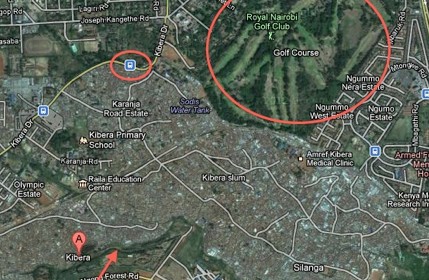
By Heather Zanoni
Gap
Kibera is made of 12 villages and is the largest slum in Kenya. Located in Nairobi, 5 kilometers from the central business district (CBD), Kibera is no more than 2.5 kilometers squared of government owned land. Population estimates range from 230,000 to 1 million people. Population density, at the low estimate, is over 90,000 per kilometer squared, compared with Manhattan, which has around 27,000 per kilometer squared and a much taller building stock (US Census Bureau, 2012). Household structures in the slums are made of corrugated iron roofs and mud walls. Structures are owned and rented out to the poor, resulting in tax-free income for structure owners (UN-Habitat, 2006).
Near the outskirts of Kibera are several gated communities and a golf course. The water mains for these upper class developments run under Kibera (Cronin and Guthrie, 2010). There is largely no running water for individual households in the slum. Water is serviced through leaky pipes in poor condition. Only 3, 4% of wastewater is treated before entering and contaminating groundwater. Sewage often seeps into the water supply, which results in the spread of preventable-but-deadly illnesses. Water supply is a key initiative being tackled by UN-Habitat with the Government of Kenya and local authorities through KENSUP (Kenya Slum Upgrading Project) and WATSAN (Kibera Integrated Water, Sanitation and Waste Management Program) through pilot projects, seen as the entry to beginning the slum upgrade process and the most pressing infrastructure challenge. Key firms within and near Kibera include several bio centers used for lavatories, kitchens, and social spaces.
Coping
Slum dwellers cope by relying on private water distributors, who charge more for providing the service. In addition, the bio centers have been implemented by NGOs and other organizations, as well as through community efforts. Slum residents are charged a user fee. In addition, some residents provide small-scale sanitation services. Many households own businesses within Kibera to make a living. Competition for jobs is high in Nairobi, so Kibera residents have created this informal economy to survive. Community members walk to work or sometimes use group vans for transportation to the CBD. Kibera residents occasionally work with aid organizations and collect data for projects such as Map Kibera Project.
Response
In order to implement slum upgrading in Kibera, structure owners should be taxed. This funding would enable the organization to invest renter’s user fees in infrastructure improvements in Kibera that landlords are not currently providing. This money could be put towards the water infrastructure projects already initiated by KENSUP and others. This could be implemented through a value capture mechanism where structure owners pay KENSUP for the increased economic benefits to their communities.
In addition, representatives from the different villages in Kibera should train on the pilot projects so they can aid in scaling up successful projects in their own villages for income.
This article is a product of Professor Shagun Mehrotra’s Global Urban Environmental Policy class. Views expressed are entirely those of the individual author.
References
Cronin, V. and Guthrie P. (2010, November 29). Alternative approaches to slum upgrading in Kibera, Nairobi. Urban Design and Planning. 129-139.
Google. (2012). Google Earth (Version 6.0.3.2197) [Software]. Available from http://www.earth.google.com
Hagen, E. (2010). Putting Nairobi’s Slums on the Map. World Bank.
UN-Habitat. (2006). Nairobi: Urban Sector Profile. United Nations Human Settlements Programme: Rapid Urban Sector Profiling for Sustainability.
UN-Habitat. (2008). UN-Habitat and the Kenya Slum Upgrading Programme: Strategy Document. UN-Habitat.
UN-Habitat. (2011). Document 02: Kenya Country Impact Study: Water and Sanitation Trust Fund Impact Study series.
U.S. Census Bureau. (2012, January 31). State & county Quickfacts: New York County, N.Y. Retrieved February 25, 2012, from http://quickfacts.census.gov.